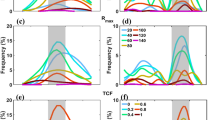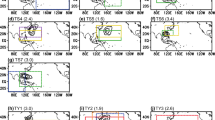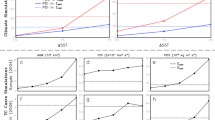Abstract
In this study the changes of tropical cyclone (TC) size from 2001 to 2021 are analyzed based on linear and quadratic curve fittings of the National Hurricane Center (NHC) / Joint Typhoon Warning Center (JTWC) best track data, based on the radius of maximum wind (RMW) and the average radius of 34-kt wind (AR34), in three oceanic basins of the North Atlantic (NATL), the Western North Pacific (WPAC) and the Eastern North Pacific (EPAC). The computations are done separately for two categories of tropical cyclones: tropical storms (TS) and hurricanes (HT). Size changes of landfalling and non-landfalling TCs are also discussed. Results show that there is a great inter-basin variability among the changes in TC sizes. Major conclusions include: 1) overall, the inner cores of TSs have become larger in all three basins, with the increasing tendencies being significant in the NATL and WAPC, while those of HTs mostly get smaller or remain similar; 2) meanwhile, comparatively large inter-basin differences are observed for the TC outer core sizes, and the sizes of landfalling TCs; 3) particularly, a significant decrease in landfalling HT outer core size is observed over the EPAC; 4) in contrast, significant increases in landfalling TS inner core size are found over the NATL and WPAC. The presented analysis results could benefit future research about TC forecasts, storm surge studies, and the cyclone climate and its changes.
Similar content being viewed by others
References
Barbosa S M (2011). Testing for deterministic trends in global sea surface temperature. J Clim, 24(10): 2516–2522
Carrasco C, Landsea C, Lin Y (2014). The influence of tropical cyclone size on its intensification. Weather Forecast, 29(3): 582–590
Chan K T F, Chan J C L (2015). Global climatology of tropical cyclone size as inferred from QuikSCAT data. Int J Climatol, 35(15): 4843–4848
Chavas D R, Emanuel K A (2010). A QuikSCAT climatology of tropical cyclone size. Geophys Res Lett, 37(18): L18816
Chavas D R, Lin N, Emanuel K (2015). A model for the complete radial structure of the tropical cyclone wind field. Part I: Comparison with observed structure. J Atmos Sci, 72(9): 3647–3662
Chen D Y C, Cheung K K W, Lee C S (2011). Some implications of core regime wind structures in western North Pacific tropical cyclones. Weather Forecast, 26(1): 61–75
Demuth J, DeMaria M, Knaff J A (2006). Improvement of advanced microwave sounder unit tropical cyclone intensity and size estimation algorithms. J Appl Meteorol Climatol, 45(11): 1573–1581
Doocy S, Dick A, Daniels A, Kirsch T D (2013). The human impact of tropical cyclones: a historical review of events 1980–2009 and systematic literature review. PLoS Curr, doi: https://doi.org/10.1371/currents.dis.2664354a5571512063ed29ed29d25ffbce74
Emanuel K (2005). Increasing destructiveness of tropical cyclones over the past 30 years. Nature, 436(7051): 686–688
Emanuel K A (2012). Self-stratification of tropical cyclone outflow. Part II: implications for storm intensification. J Atmos Sci, 69(3): 988–996
Emanuel K A, Sobel A (2013). Response of tropical sea surface temperature, precipitation, and tropical cyclone-related variables to changes in global and local forcing. J Adv Model Earth Syst, 5(2): 447–458
Emanuel K A, Sundararajan R, Williams J (2008). Hurricanes and global warming: results from downscaling IPCC AR4 simulations. Bull Am Meteorol Soc, 89(3): 347–368
Grinsted A, Moore J C, Jevrejeva S (2012). Homogeneous record of Atlantic hurricane surge threat since 1923. Proc Natl Acad Sci USA, 109(48): 19601–19605
Irish J L, Resio D T, Ratcliff J J (2008). The influence of storm size on hurricane surge. J Phys Oceanogr, 38(9): 2003–2013
Islam M R, Lee C Y, Mandli K T, Takagi H (2021). A new tropical cyclone surge index incorporating the effects of coastal geometry, bathymetry and storm information. Sci Rep, 11(1): 16747
Islam M R, Satoh M, Takagi H (2022). Tropical cyclones affecting Japan central coast and changing storm surge hazard since 1980. J Meteorol Soc Jpn, 100(3): 493–507
Jin F F, Boucharel J, Lin I I (2014). Eastern Pacific tropical cyclones intensified by El Niño delivery of subsurface ocean heat. Nature, 516(7529): 82–85
Kimball S K, Mulekar M S (2004). A 15-year climatology of North Atlantic tropical cyclones. Part I: Size parameters. J Climate, 17: 3555–3575
Kishimoto K (2008). Revision of JMA’s early stage Dvorak analysis and its use to analyze tropical cyclones in the early developing stage. RSMC Tokyo-Typhoon Center Technical Review, 10: 1–12
Klotzbach P J (2006). Trends in global tropical cyclone activity over the past twenty years (1986–2005). Geophys Res Lett, 33(10): L10805
Klotzbach P J, Bell M M, Bowen S G, Gibney E J, Knapp K R, Schreck C J (2020). Surface pressure a more skillful predictor of normalized hurricane damage than maximum sustained wind. Bull Am Meteorol Soc, 101(6): E830–E846
Klotzbach P J, Landsea C W (2015). Extremely intense hurricanes: revisiting Webster et al. (2005) after 10 Years. J Clim, 28(19): 7621–7629
Knaff J A, Longmore S P, Molenar D A (2014). An objective satellite-based tropical cyclone size climatology. J Clim, 27(1): 455–476
Knapp K R, Kruk M C, Levinson D H, Diamond H J, Neumann C J (2010). The International Best Track Archive for Climate Stewardship (IBTrACS): unifying tropical cyclone best track data. Bull Am Meteorol Soc, 91(3): 363–376
Kossin J P (2017). Hurricane intensification along United States coast suppressed during active hurricane periods. Nature, 541(7637): 390–393
Landsea C W, Franklin J L (2013). Atlantic hurricane database uncertainty and presentation of a new database format. Mon Weather Rev, 141(10): 3576–3592
Landsea C W, Pielke Jr R A, Mestas-Nunez A M, Knaff J A (1999). Atlantic basin hurricanes: indices of climatic changes. Climatic Change, 42(1): 89–129
Landsea C W, Vecchi G A, Bengtsson L, Knutson T R (2010). Impact of duration thresholds on Atlantic tropical cyclone counts. J Clim, 23(10): 2508–2519
Lin Y, Zhao M, Zhang M (2015). Tropical cyclone rainfall area controlled by relative sea surface temperature. Nat Commun, 6(1): 6591
Martinez-Sanchez J N, Cavazos T (2014). Eastern Tropical Pacific hurricane variability and landfalls on Mexican coasts. Clim Res, 58(3): 221–234
McDonald J H (2014). Handbook of Biological Statistics (3rd ed.). Baltimore: Sparky House Publishing
Mei W, Xie S P, Primeau F, McWilliams J C, Pasquero C (2015). Northwestern Pacific typhoon intensity controlled by changes in ocean temperatures. Sci Adv, 1(4): e1500014
Merrill R T (1984). A comparison of large and small tropical cyclones. Mon Weather Rev, 112(7): 1408–1418
Nekkali Y S, Osuri K K, Das A K (2022). Numerical modeling of tropical cyclone size over the Bay of Bengal: influence of microphysical processes and horizontal resolution. Meteorol Atmos Phys, 134(4): 72
Rotunno R, Emanuel K A (1987). An air-sea interaction theory for tropical cyclones. Part II: evolutionary study using a nonhydrostatic axisymmetric numerical model. J Atmos Sci, 44(3): 542–561
Shen W (2006). Does the size of hurricane eye matter with its intensity? Geophys Res Lett, 33(18): L18813
Shou H R, Li T, Sun Y, Wang L, Liu J (2021). Decreasing trend of western North Pacific tropical cyclone inner-core size over the past decades. J Meteorol Res, 35(4): 635–645
Stern D P, Vigh J L, Nolan D S, Zhang F (2015). Revisiting the relationship between eyewall contraction and intensification. J Atmos Sci, 72(4): 1283–1306
Takagi H, Wu W (2016). Maximum wind radius estimated by the 50 kt radius: improvement of storm surge forecasting over the western North Pacific. Nat Hazards Earth Syst Sci, 16(3): 705–717
Wang B, Yang Y, Ding Q H, Murakami H, Huang F (2010). Climate control of the global tropical storm days (1965–2008). Geophys Res Let, 37: L07704
Webster P J, Holland G J, Curry J A, Chang H R (2005). Changes in tropical cyclone number, duration, and intensity in a warming environment. Science, 309(5742): 1844–1846
Xu J, Wang Y (2010a). Sensitivity of the simulated tropical cyclone inner-core size to the initial vortex size. Mon Weather Rev, 138(11): 4135–4157
Xu J, Wang Y (2010b). Sensitivity of tropical cyclone inner-core size and intensity to the radial distribution of surface entropy flux. J Atmos Sci, 67(6): 1831–1852
Xu J, Wang Y, Tan Z M (2016). The relationship between sea surface temperature and maximum intensification rate of tropical cyclones in the North Atlantic. J Atmos Sci, 73(12): 4979–4988
Acknowledgments
This work is supported by the Guangdong Province Introduction of Innovative R&D Team Project China (No. 2019ZT08G669), the Guangdong Basic and Applied Basic Research Foundation (No. 2020A1515110275), the Guangdong Science and Technology Key Project (No. 21080208). We would also like to thank the HWRF team of NOAA/NCEP/EMC for making this study possible.
Author information
Authors and Affiliations
Corresponding author
Ethics declarations
Competing Interests The authors declare that they have no competing interests.
Rights and permissions
About this article
Cite this article
Zhang, B., Leung, J.CH., Liu, S. et al. Changes of tropical cyclone size in three oceanic basins of the northern hemisphere from 2001 to 2021. Front. Earth Sci. (2024). https://doi.org/10.1007/s11707-022-1064-4
Received:
Accepted:
Published:
DOI: https://doi.org/10.1007/s11707-022-1064-4




